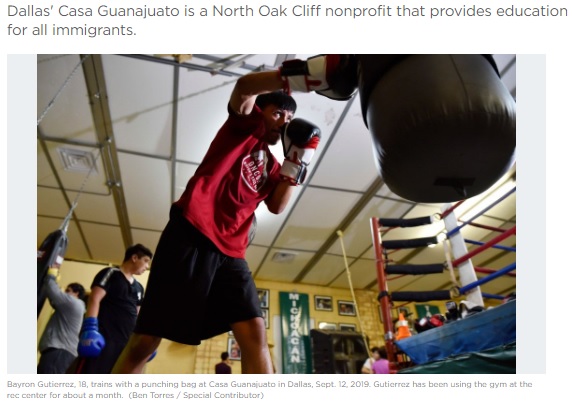The largest contingent of Mexicans in North Texas is celebrating the 25th anniversary of the community center at the heart of Guanajuatense culture, a nonprofit that provides education and outreach for all immigrants.
Although 950 miles separate Dallas from the Mexican state of Guanajuato, an estimated 300,000 Guanajuatenses live in North Texas. Many have used services or volunteered at Casa Guanajuato in North Oak Cliff. The center’s anniversary will be celebrated Saturday with a day of free music and cultural events.
“We are a bridge between our community and Guanajuato. We just serve as a link. … Our goal is to be a place where our community can get education and training,” said founder Tereso Ortiz, 70.
The Guanajuatense community’s roots reach as far back as World War II, when some Mexicans arrived with work permits to make up for the shortage of American workers during the war. Many settled down with their families.
/arc-anglerfish-arc2-prod-dmn.s3.amazonaws.com/public/CXYNENFQ627CDSKRWZ6BRA2NE4.jpg)
Ortiz says he wanted to preserve ties between Dallas Guanajuatense and the culture of Guanajuato.
“A priest friend of mine sent me a letter that said: ‘Wherever you are, don’t forget where you’re from, don’t forget your roots, your moral and religious tenets, your tradition, your culture,’ ” Ortiz recalled. “All of a sudden, I understood … that any good moral principle you learned at home, if you don’t practice it, it gets lost.”
The center began operations on Sept. 18, 1994. In addition to preserving and promoting Guanajuatense traditions, it offers English and citizenship classes, adult education and GED courses, as well as a venue for community celebrations.
And then there’s the boxing gym, a highlight of the center’s successes where children and youth train.
Remi Muñoz, 47, from Piedras Negras, Coahuila, has been the boxing coach at Casa Guanajuato for nine years. He prides himself in having some of his students represent the community in several competitions.
“I think this is a beautiful thing because the kids stay away from drugs, and what they learn here is for boxing, not for the streets. They take it very responsibly,” Muñoz said. “Next month, two of our kids will be at a championship and that makes our community very proud.”
/arc-anglerfish-arc2-prod-dmn.s3.amazonaws.com/public/O5AWUAOBXRMRXINGN4EMDD2UMY.jpg)
1/2Children of all ages do warm-up exercises before they begin their boxing lesson at Casa Guanajuato in Dallas, Sept. 12, 2019. (Ben Torres / Special Contributor)
/arc-anglerfish-arc2-prod-dmn.s3.amazonaws.com/public/PIEWMEQASH7YMRXKILLBKMF3HE.jpg)
2/2Children of all ages do warm-up exercises before they begin their boxing lesson at Casa Guanajuato in Dallas, Sept. 12, 2019.(Ben Torres / Special Contributor)
Norma Flores, who is from El Salvador, has been visiting Casa Guanajuato almost daily for three years.
“I was looking for a place where my daughter could keep herself busy. Now she wants to come every day,” she said. “She keeps moving and returns home tired.”
Casa Guanajuato is in a 10,500-square-foot building decorated with a mural depicting postcards from the state and an image of Our Lady of Guadalupe.
The center has been a meeting place not only for Guanajuatenses living in North Texas, but also for high-profile politicians and leaders from the Mexican state who come to strengthen bonds and foster business opportunities.
In 1996, Vicente Fox, who was governor of Guanajuato at the time and who would go on to become Mexico’s president, visited. This weekend, Casa Guanajuato is expecting the current governor, Diego Sinhue Rodríguez Vallejo.
/arc-anglerfish-arc2-prod-dmn.s3.amazonaws.com/public/J7JKYPJ5QJQQWPFQM27BDNXQS4.jpg)
1/2Instructor Jacinta Hernandez, left, conducts a lesson during a citizenship class at Casa Guanajuato in Dallas, Sept. 12, 2019. (Ben Torres / Special Contributor)
/arc-anglerfish-arc2-prod-dmn.s3.amazonaws.com/public/HIP3RT2PDGWJAJ7ZNGEXGLCGTQ.jpg)
2/2Angelina Alvarado, 60, of Dallas, follows along from a book during a citizenship class at Casa Guanajuato in Dallas, Sept. 12, 2019. (Ben Torres / Special Contributor)
If the community center is the heart of Guanajuatense culture in Dallas, then Ortiz is the blood that keeps it pumping.
“Tereso Ortiz’s work is consistent, all-inclusive and ground-breaking,” said Francisco de la Torre, the Mexican consul in Dallas. “His represents a morally responsible, long-standing leadership. We at the consulate rely on him a lot. I wished every city had its own Don Tereso. That would make the Mexican community’s life much easier.”
Those who work with Ortiz say, beyond being the center’s director, he also performs a role more akin to that of mentor. His phone is constantly ringing. More often than not, it’s members of the community asking for guidance.
María Hernández, from Álamos de Martínez, a small town in the northeast part of the state, has volunteered in Casa Guanajuato on and off for 20 years. She works in the cafeteria.
“We moved to a house nearby, so we started coming and saw their activities. I have found a family here. Don Tereso and his family are like my family.”
Ortiz insists he’s just working for the community, and he credits the center’s volunteers for what’s been accomplished.
“The biggest success is understanding that without risk, there is no merit,” Ortiz said. “When I crossed the river, I didn’t imagine what was awaiting me. You don’t have to be afraid, You should never look back. Don’t pay heed to criticism, because some people think differently. And most of all, be respectful.”

